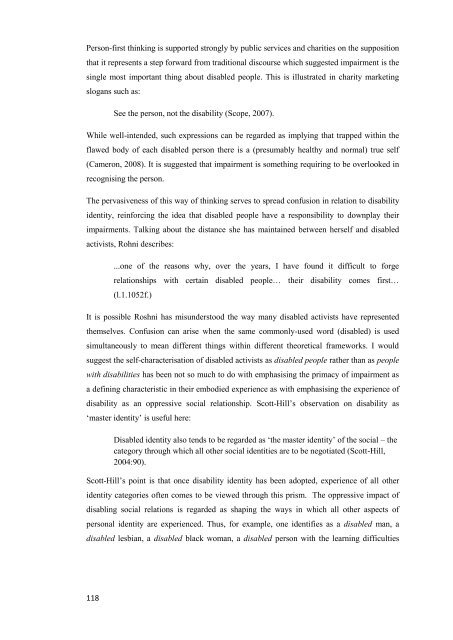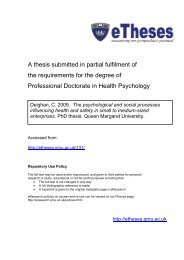A thesis submitted in partial fulfilment of - Etheses - Queen Margaret ...
A thesis submitted in partial fulfilment of - Etheses - Queen Margaret ...
A thesis submitted in partial fulfilment of - Etheses - Queen Margaret ...
Create successful ePaper yourself
Turn your PDF publications into a flip-book with our unique Google optimized e-Paper software.
Person-first th<strong>in</strong>k<strong>in</strong>g is supported strongly by public services and charities on the supposition<br />
that it represents a step forward from traditional discourse which suggested impairment is the<br />
s<strong>in</strong>gle most important th<strong>in</strong>g about disabled people. This is illustrated <strong>in</strong> charity market<strong>in</strong>g<br />
slogans such as:<br />
118<br />
See the person, not the disability (Scope, 2007).<br />
While well-<strong>in</strong>tended, such expressions can be regarded as imply<strong>in</strong>g that trapped with<strong>in</strong> the<br />
flawed body <strong>of</strong> each disabled person there is a (presumably healthy and normal) true self<br />
(Cameron, 2008). It is suggested that impairment is someth<strong>in</strong>g requir<strong>in</strong>g to be overlooked <strong>in</strong><br />
recognis<strong>in</strong>g the person.<br />
The pervasiveness <strong>of</strong> this way <strong>of</strong> th<strong>in</strong>k<strong>in</strong>g serves to spread confusion <strong>in</strong> relation to disability<br />
identity, re<strong>in</strong>forc<strong>in</strong>g the idea that disabled people have a responsibility to downplay their<br />
impairments. Talk<strong>in</strong>g about the distance she has ma<strong>in</strong>ta<strong>in</strong>ed between herself and disabled<br />
activists, Rohni describes:<br />
...one <strong>of</strong> the reasons why, over the years, I have found it difficult to forge<br />
relationships with certa<strong>in</strong> disabled people… their disability comes first…<br />
(l.1.1052f.)<br />
It is possible Roshni has misunderstood the way many disabled activists have represented<br />
themselves. Confusion can arise when the same commonly-used word (disabled) is used<br />
simultaneously to mean different th<strong>in</strong>gs with<strong>in</strong> different theoretical frameworks. I would<br />
suggest the self-characterisation <strong>of</strong> disabled activists as disabled people rather than as people<br />
with disabilities has been not so much to do with emphasis<strong>in</strong>g the primacy <strong>of</strong> impairment as<br />
a def<strong>in</strong><strong>in</strong>g characteristic <strong>in</strong> their embodied experience as with emphasis<strong>in</strong>g the experience <strong>of</strong><br />
disability as an oppressive social relationship. Scott-Hill‟s observation on disability as<br />
„master identity‟ is useful here:<br />
Disabled identity also tends to be regarded as „the master identity‟ <strong>of</strong> the social – the<br />
category through which all other social identities are to be negotiated (Scott-Hill,<br />
2004:90).<br />
Scott-Hill‟s po<strong>in</strong>t is that once disability identity has been adopted, experience <strong>of</strong> all other<br />
identity categories <strong>of</strong>ten comes to be viewed through this prism. The oppressive impact <strong>of</strong><br />
disabl<strong>in</strong>g social relations is regarded as shap<strong>in</strong>g the ways <strong>in</strong> which all other aspects <strong>of</strong><br />
personal identity are experienced. Thus, for example, one identifies as a disabled man, a<br />
disabled lesbian, a disabled black woman, a disabled person with the learn<strong>in</strong>g difficulties




